

Sir Henry de Raleigh (died 1301) was a knight from Devonshire, England, whose effigy in the form of a cross-legged crusader knight survives in Exeter Cathedral.


Sir Henry de Raleigh (died 1301) was a knight from Devonshire, England, whose effigy in the form of a cross-legged crusader knight survives in Exeter Cathedral.
The place of his origin is unclear from surviving records, but he was probably a member of the prominent de Raleigh family seated at the manor of Raleigh in the parish of Pilton, near Barnstaple in North Devon. In the 16th century the arms of Checquy a chief vair were recorded by the antiquarian John Leland as painted on the shield of his effigy in Exeter Cathedral. These arms were later adopted by the prominent Chichester family, the heirs of de Raleigh of Raleigh, Pilton.
He is known to have died whilst living at the Dominican Friary in Exeter, whence his body was forcibly removed by two Cathedral canons, including Walter de Stapledon (d.1326), later Bishop of Exeter, and given burial in the Cathedral. [2]

The Devon historian Sir William Pole (d.1635) wrote concerning Exeter Cathedral:
It is not certain which of the two contemporary effigies of cross-legged knights situated next to each other under separate niches set into the north wall of the south ambulatory of Exeter Cathedral represents Raleigh. Orme (2008) is one of the few commentators who has attempted to decide the matter, and he selected the westernmost (left-hand) effigy, under the arched canopy, as representing Raleigh, thus assigning de Bohun to the easternmost effigy, under the ogee-shaped canopy. The cross-legged and "lively" form of these effigies, of which several exist elsewhere in England, most notably in the Temple Church in the City of London, are generally supposed to represent crusaders, possibly members of the Knights Templar order.

Walter de Stapledon was Bishop of Exeter 1308–1326 and twice Lord High Treasurer of England, in 1320 and 1322. He founded Exeter College, Oxford and contributed liberally to the rebuilding of Exeter Cathedral. His tomb and monument, of great architectural importance, survives in Exeter Cathedral.

Arlington was a manor, and is a village and civil parish in the North Devon district of Devon in England. The parish includes the villages of Arlington and Arlington Beccott. The population of the parish is 98.

Sir William Peryam of Little Fulford, near Crediton in Devon, was an English judge who, in 1593, rose to the position of Lord Chief Baron of the Exchequer and was knighted by Queen Elizabeth I.
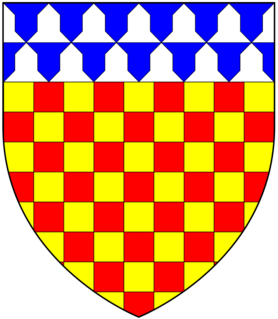
There have been three baronetcies created for persons with the surname Chichester, one in the Baronetage of England and two in the Baronetage of the United Kingdom. Only the 1641 creation is extant.

Sir John Chichester (1519/20-1569) of Raleigh in the parish of Pilton, near Barnstaple in North Devon, was a leading member of the Devonshire gentry, a naval captain, and ardent Protestant who served as Sheriff of Devon in 1550-1551, and as Knight of the Shire for Devon in 1547, April 1554, and 1563, and as Member of Parliament for Barnstaple in 1559, over which borough his lordship of the manor of Raleigh had considerable influence.

The historic manor of Raleigh, near Barnstaple and in the parish of Pilton, North Devon, was the first recorded home in the 14th century of the influential Chichester family of Devon. It was recorded in the Doomsday Book of 1086 together with three other manors which lay within the later created parish of Pilton. Pilton as a borough had existed long before the Norman Conquest and was one of the most important defensive towns in Devon under the Anglo-Saxons. The manor lies above the River Yeo on the southern slope of the hill on top of which exists the ruins of the Anglo-Saxon hillfort of Roborough. The historic manor of Raleigh is now the site of the North Devon District Hospital.

Hall is a large estate within the parish and former manor of Bishop's Tawton, Devon. It was for several centuries the seat of a younger branch of the prominent and ancient North Devon family of Chichester of Raleigh, near Barnstaple. The mansion house is situated about 2 miles south-east of the village of Bishop's Tawton and 4 miles south-east of Barnstaple, and sits on a south facing slope of the valley of the River Taw, overlooking the river towards the village of Atherington. The house and about 2,500 acres of surrounding land continues today to be owned and occupied by descendants, via a female line, of the Chichester family. The present Grade II* listed neo-Jacobean house was built by Robert Chichester between 1844 and 1847 and replaced an earlier building. Near the house to the south at the crossroads of Herner the Chichester family erected in the 1880s a private chapel of ease which contains mediaeval woodwork saved from the demolished Old Guildhall in Barnstaple.
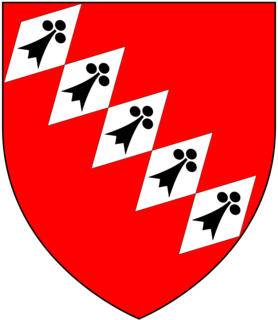
Sir John Hele of Wembury in Devon, serjeant-at-law, was a Member of Parliament for Exeter and was Recorder of Exeter (1592–1605). He was one of Prince's Worthies of Devon (1701). He built at Wembury one of the grandest manor houses ever seen in Devon, called by his near contemporary Risdon : "A magnificent house, equalling, if not exceeding, all other in these western parts, for uniform building; a sightly seat for shew; for receipt spacious; for cost sumptuous; for sight salubrious". It was already a ruin by about 1700, and was finally demolished in 1803. He founded a boys' hospital in Plymouth. His monument and effigy survives in Wembury Church.

The Bohun swan was a heraldic badge used originally in England by the mediaeval noble family of de Bohun, Earls of Hereford, and Earls of Essex.

The manor of Wadham in the parish of Knowstone in north Devon and the nearby manors of Chenudestane and Chenuestan are listed in the Domesday Book of 1086:

Sir William Huddesfield of Shillingford St George in Devon, was Attorney-General to Kings Edward IV (1461–1483) and Henry VII (1485–1509). He built the tower of St George's Church, Shillingford.
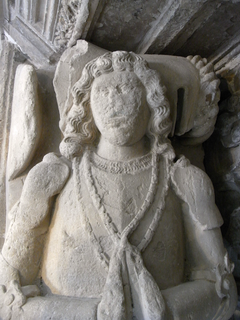
Sir John Speke (1442–1518) of Whitelackington, Somerset and of Heywood in the parish of Wembworthy and of Bramford Speke both in Devon, was Sheriff of Devon in 1517 and a Member of Parliament (1477). He was knighted in 1501. His monument is the Speke Chantry in Exeter Cathedral in which survives his recumbent effigy.

,

Sir John Sully, KG, of Ruxford and Iddesleigh in Devonshire, was an English knight. He was one of the many deponents who gave evidence in Scrope v Grosvenor, one of the earliest heraldic law cases brought in England, at which time he stated his age as 105. In about 1362, he was appointed by King Edward III as the 39th Knight of the Garter.
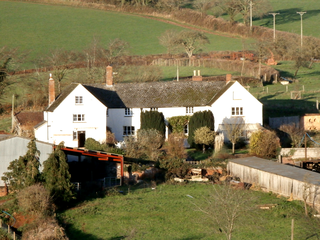
Ruxford is an historic estate in the parish of Sandford, near Crediton in Devon.
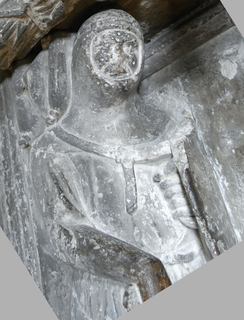
Sir Richard de Stapledon of Annery in the parish of Monkleigh, North Devon, England, was a judge and the elder brother of Walter de Stapledon (1261-1326), Bishop of Exeter. His effigy and monument survive in Exeter Cathedral.
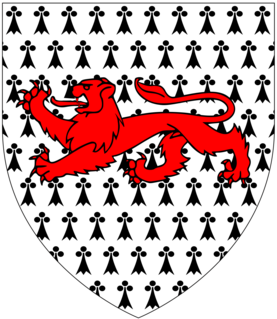
The Drewe family of Broadhembury were for many generations owners and inhabitants of The Grange, Broadhembury, Devon, in the west of England, from the 16th to 19th centuries.

Sir John Chichester lord of the manor of Raleigh in the parish of Pilton, near Barnstaple, North Devon, was Sheriff of Devon in 1576/7 and/or in 1585 and died of gaol fever contracted whilst acting as a magistrate at the Lent Black Assizes of Exeter in 1586.

Richard Chichester (1423-1496), lord of the manor of Raleigh in the parish of Pilton, near Barnstaple, North Devon, was twice Sheriff of Devon, in 1469 and 1475.

Fardel is an historic manor in the parish of Cornwood, in the South Hams district of Devon. It was successively the seat of the Raleigh and Hele families. The surviving Grade I listed medieval manor house is situated about half-way between Cornwood and Ivybridge, just outside the Dartmoor National Park on its south-western border.